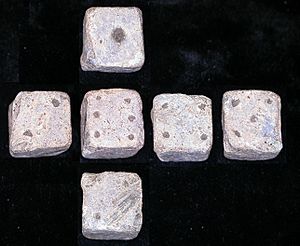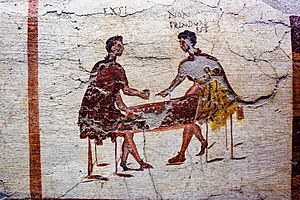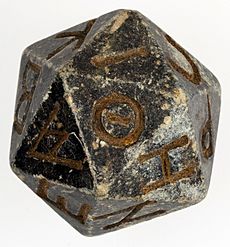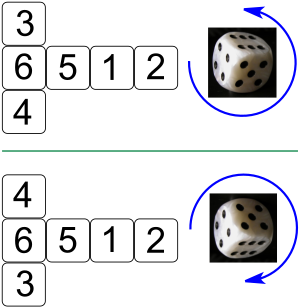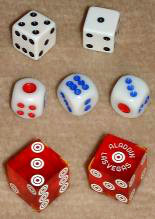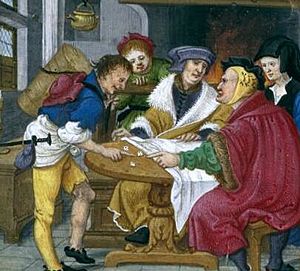Dice facts for kids
Dice are small objects you can throw. They have different marks or numbers on their sides. When you roll a die, it lands in a random way. This makes dice perfect for creating random results. You often see them in tabletop games. These include dice games, board games, and role-playing games.
A common die is a cube with six sides. Each side has a different number of dots, called pips, from one to six. When you roll it, the die stops with one side facing up. This top side shows a random number from one to six. Each number has an equal chance of appearing. Dice can also have many different shapes. Some have numbers or symbols instead of pips. Special dice called loaded dice are made to land on certain numbers more often.
Contents
The Long History of Dice
Dice have been around for a very long time. We don't know exactly where they first came from. Some people think dice came from using animal bones for fortune-telling. These bones were called knucklebones.
In Ancient Egypt, people played a game called senet. This game used flat, two-sided sticks. These sticks worked like dice to show how many spaces a player could move. The oldest known dice were found in Iran. They were part of a game set from around 2800 to 2500 BCE. Bone dice found in Scotland are even older, from 3100–2400 BCE. In ancient India, games with dice are mentioned in old writings. The Bible also talks about "casting lots," which was similar to using dice.
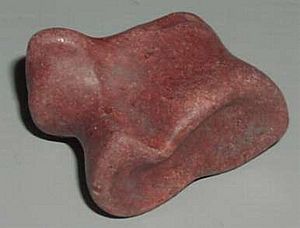
The Romans loved playing with dice, even though it was against the law. They had two main types of dice. Tali were larger dice with numbers one, three, four, and six on their four sides. Tesserae were smaller dice with numbers one to six. We even have twenty-sided dice from ancient Egypt, dating back to 200 BCE!
Dice also led to other games. Dominoes and playing cards first appeared in China. They developed from dice games around the Tang Dynasty (618–907 CE). In Japan, dice were used for a popular game called sugoroku. One type, Ban-sugoroku, is like backgammon. Another type, e-sugoroku, is a racing game.
How Dice Are Used
You can throw dice from your hand or from a special cup. The number on the top side of the die is your result. The way a die rolls is based on physics. But small things, like tiny movements in your hand, make the result seem random. This is why dice are a simple way to get a random number.
A popular dice game is craps. In craps, two dice are thrown together. People bet on the total value of the two dice. Dice are also often used in board games. They help decide how far a game piece moves, like in backgammon or Monopoly.
How Dice Are Made
Arrangement of Pips
Most common dice are small cubes, about 1.6 cm (0.6 inches) across. Their faces are numbered with round dots called pips. Sometimes, you might see dice with regular numbers instead of dots, but these are less common.
On a modern die, the numbers on opposite sides always add up to seven. For example, the 1 is opposite the 6, the 2 is opposite the 5, and the 3 is opposite the 4. The 1, 2, and 3 faces meet at one corner. If these numbers go counterclockwise around that corner, the die is "right-handed." If they go clockwise, it's "left-handed." Most Western dice are right-handed, while Chinese dice are usually left-handed.
The pips on standard six-sided dice have special patterns. Asian-style dice have similar patterns, but the pips are closer to the center. Also, the pips on Asian dice can be different sizes. The 1 and 4 sides are often colored red on Asian dice.
Manufacturing Process
Most dice are made from plastic using a process called injection molding. The dots or numbers are part of the mold. Different colors can be added to the plastic. This makes dice opaque, transparent, or even speckled.
To color the numbers, the whole die is dipped in paint. After the paint dries, the die is polished. This polishing scrapes off all the paint except for the paint inside the indented numbers. This process also makes the edges of the dice smooth and rounded.
Special dice for casinos are made very carefully. Their pips are drilled out, then filled with paint. This paint has the same density as the die's material. This makes sure the die's weight is perfectly balanced. Casino dice also have a serial number to prevent cheating.
Cool Dice Words
The words ace, deuce, trey, cater, cinque, and sice used to mean 1, 2, 3, 4, 5, and 6 on a die. These words are not used much anymore, but some professional gamblers still use them. Ace comes from a Latin word meaning "a unit."
When you roll two dice, some combinations have fun slang names. Snake eyes means rolling a one on each die. The term has been used since at least 1919. Boxcars or midnight means rolling a six on each die. The two sixes look like the ends of boxcars on a train. Many rolls have special names in the game of craps.
Special Dice and Their Uses
Loaded Dice
A loaded die is one that has been changed so it lands on certain sides more often. This can be done by rounding some faces or adding small weights inside. Casinos often use clear dice. This makes it easier to see if someone has tried to tamper with them.
Dice in Games
Many board games use dice to add randomness. Dice can decide how far pieces move or help settle conflicts. Usually, rolling higher numbers is better. But some games, like Castles of Burgundy, use dice differently. In that game, the value of the die might decide what action you can take. A six isn't necessarily better than a one. In games like Quarriors, different sides of the dice can give you different powers or resources.
Dice for Fortune-Telling
Dice can also be used for divination, which is a way to try and predict the future. This is called cleromancy. Sometimes, people use two regular dice for this. Tibetan Buddhists use a similar method. The ancient Greeks, especially the Pythagoreans, might have used dice shaped like Platonic solids. They called them "the dice of the gods."
Dice in Role-Playing Games
Polyhedral dice are very common in role-playing games (RPGs). The fantasy RPG Dungeons & Dragons (D&D) helped make these dice popular. Some RPGs use only one type of die, like Exalted, which uses only ten-sided dice. Other games, like D&D, use many different types of dice. Dice help decide what happens in the game. Players often roll dice and add or subtract numbers based on their character's skills. To keep track of rolls, players often use dice notation.
There are also special astrological dice. These are three 12-sided dice used for fortune-telling. One die shows planets, another shows zodiac signs, and the third shows astrological houses. A special 20-sided die is used in the Magic 8 Ball to answer yes-or-no questions.
Dice for Passwords
Dice can even be used to create random numbers for passwords and cryptography. The Electronic Frontier Foundation suggests a method to make strong passphrases using dice. This method, called Diceware, involves rolling five dice repeatedly. You then pick words from a special list based on your rolls. This helps create passwords that are both secure and easy to remember.
See also
 In Spanish: Dado para niños
In Spanish: Dado para niños



